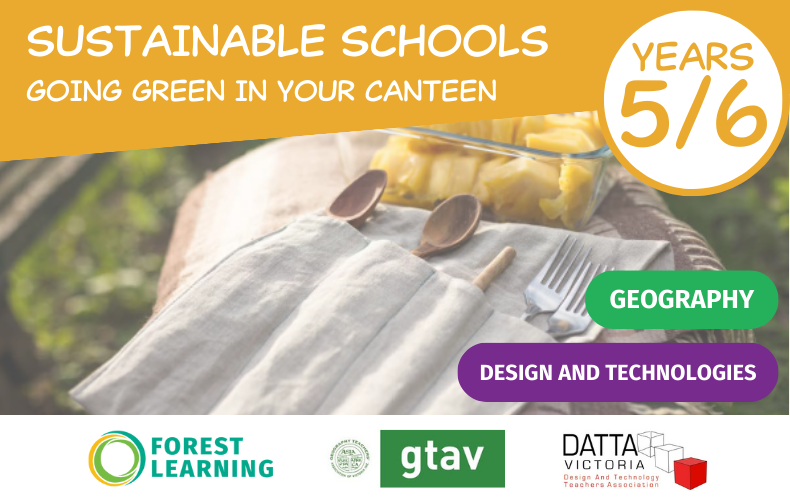Geography & Design and Technologies Years 5/6: Sustainable Schools: Going Green in Your Canteen
Lesson Overview:
As Australians and global citizens, we all have a part to play in our planet’s future. Choosing more sustainable options when it comes to buying everyday products, such as the clothes we wear, packaging materials, to the energy sources we use every day, can all play a part. Choosing renewable resources such as solar, wind, or wood and wood fibre from trees offers one solution to reach our sustainability targets. In choosing renewable resources over non-renewable resources such as coal, crude oil and gas, we also gain a benefit of using less of these non-renewable resources that work to increase global carbon emissions.
What’s in the resource
- Student Workbook – two formats of pdf available:
- Printable version with lines, or
- Online digital interactive pdf version that could be used as a student assessment option.
- Teacher Workbook – complete with lesson outcomes and Australian Curriculum links, answers to all questions found within the Student Workbook, curriculum overview and mapping, Forest Glossary, lesson timings, suggested groupings for activites, extension activities, teacher tips, assessment options, references and all links.
- Embeds Ed Tech including ForestVR video experiences. All Ed Tech is available to view on any device or technology a school / student already owns including laptop, smart board, ipad or VR Headset.
- Multimedia-rich
Lesson Sequence
LESSONS 1-2 HASS (Geography) – Sustainable Forests Creating a Sustainable Future
AIM: For students to better understand forests and their distribution within Australia and understand the value of managing forests as a sustainable and renewable resource.
OUTCOMES: Students will:
- Explore their current understanding of forest characteristics and distributions at various scales.
- Use maps and other geographical sources to interpret data and describe patterns.
- Understand how we use and manage forest resources in Australia.
- Use videos and flow diagrams to illustrate interconnections and processes.
LESSONS 3-8 Design and Technologies – Sustainable Materials
AIM: For students to investigate single-use products and their use in society and at school and assess attitudes and needs in the school tuckshop for single-use products such as disposable cutlery. Using this information, students will then generate a design, safely produce and evaluate a reusable cutlery pouch made from the sustainable wood-fibre fabric, rayon.
OUTCOMES: Students will:
- Investigate materials, their sustainability features, and suitability to be used to produce a reusable cutlery pouch.
- Develop a design brief and generate a graphical representation of a reusable cutlery pouch to meet sustainability criteria and researched needs.
- Produce a reusable cutlery pouch using different tools, techniques and safety procedures.
- Evaluate and communicate through a class showcase their end products.
LESSON 9 HASS (Geography) & Design and Technologies – Looking Back, Looking Forwards
AIM: For students to critically reflect upon their learning throughout the unit and summarise their understanding of the use and management of productive forests and wood fibre materials.
OUTCOMES Students will:
- Use critical reflection skills to consider and justify opinions.
- Express ideas to the class and think creatively as a group.
Background to this Resource
Related Resources:
What are the Material Alternatives - PowerPoint
What are the Material Alternatives? PPTYear Level/s:
Key Curriculum Areas / Subject:
National Curriculum Codes:
Strand Content Description:
N/A
General Capabilities:
Cross Curriculum Priorities:
Curriculum Connections:
ScOT Catalogue Terms:
Theme/s:
Resource Type/s:
Primary:
UnitSecondary:
Lesson, Multimedia, Activity, Ed Tech (VR/Drones), Fact Sheet, Wood and Fibre Projects, Workbook/Worksheet
teacher Resource
Sustainable Schools Yrs5-6 Geography + D&T - Teacher Resource: DIGITAL version
Interactive teacher PDF workbook with answers and notes to guide you through running activities and lessons.
File Size: 15.32 MB
File Type: pdf
Loginteacher Resource
Sustainable Schools Yrs5-6 Geography + D&T - Teacher Resource: PRINT version
Printable teacher PDF workbook with answers and notes to guide you through running activities and lessons.
File Size: 26.74 MB
File Type: pdf
Loginstudent Resource
Sustainable Schools Yrs5-6 Geography + D&T - Student Resource: DIGITAL version
Interactive Student PDF workbook for use on a laptop or PC.
File Size: 7.41 MB
File Type: pdf
Loginstudent Resource
Sustainable Schools Yrs5-6 Geography + D&T - Student Resource: PRINT version
Printable student PDF workbook - with lines for student written answers.
File Size: 18.61 MB
File Type: pdf
Loginteacher Resource
Sustainable Schools Yrs5-6 Geography + D&T - PowerPoint
PowerPoint presentation for use as part of Lesson 5 - Activity 1 - Resource 11: Material Properties, or by itself as a classroom discussion tool.
File Size: 27.79 MB
File Type: pptx
Login